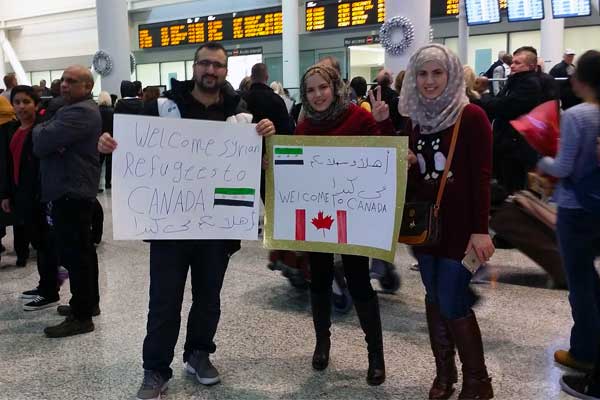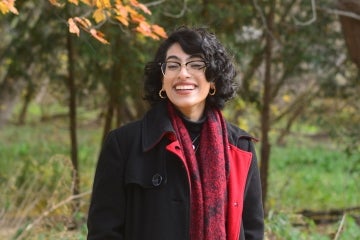
Syrian refugees in public school: OISE experts say one size does not fit all
Published: January 5, 2016
As Syrian refugee families arrive in Canada, schools are preparing to welcome their children into their classrooms.
U of T News spoke with Esther Geva and Charles E. Pascal, professors in the department of applied psychology and human development at the Ontario Institute for Studies in Education (OISE), about the challenges facing refugee children and what schools can do to support them.
Read more about the refugee crisis
Geva’s research is focused on the development of language and literacy skills in students from diverse linguistic backgrounds. Pascal’s expertise lies in early and higher education, public policy and leadership development.
What challenges will the refugee children face when they start school in Canada?
EG: Let me start by stating the obvious – one size does not fit all. Naturally, language will be the first challenge, as it is with other “new Canadian” children who don’t speak English or French. When we think of typical newcomers, it is important to remember that adolescents may be more at risk because of the academic language demands presented in high school.
We also need to distinguish between those who went to school on a regular basis and those whose education was interrupted. Those who went to school should do OK, given enough time to develop language and reading skills. Those who missed school will need to be taught basic skills and allowed time to do lots of catching up.
CP: Some students may have learning disabilities, which are often undiagnosed in newcomers. As well, we need to think of how other students support the social and emotional needs of the refugee kids. Whether or not the cultural differences are actively respected depends on the quality of school leadership, the approach taken by teachers and the training of mental health professionals to work with diverse cultural groups..
How are parents implicated in the integration of refugee students?
CP: What is going on with parents will have a huge impact. What employment opportunities are available to them? What is their education level? How are they coping with the stresses of relocation? Some parents will feel comfortable being involved with the school, others will not. All of these things vary markedly from family to family and affect children.
EG: Exactly. Stress related to trauma is difficult enough but then there is stress related to changes in family dynamics. For example, some refugee children will learn English (or French) and undertake a heavy load beyond their developmental level in becoming the “spokesperson” for the family when negotiating with the world. Or consider what might be the effect when a mother manages to get a job and the “man of the house” is unemployed. Will cultural differences lead to stress in the family and mismatch among family members in level of acculturation?
What kind of support will schools need to provide? What can teachers do to prepare?
CP: Teachers shouldn’t make any assumptions about each student’s situation or ability. Great teaching rests with an educator’s ability to adapt to individual differences. As we noted, what is the education level of the parents? Did the children attend school regularly in Syria? What are the special circumstances or needs of each student? What are the special interests of each student? What was their journey to Canada like? Great teachers know about their students and allow them to share their experiences and know how to support them..
Can we take this level attention for granted?
CP: Many teachers and schools are superb at dealing with cultural diversity and other major differences in interest and ability levels in various subjects and the like. Is this a universal reality in Ontario? No. In my view, it is a question of local school leadership. I assume that school boards know where the “diversity stars” are among their school principals and will take this into consideration.
Will there be concerns about larger classes?
CP: Class size is not an excuse. Research is clear that quality teaching trumps class size. Good teachers know their kids and support their success. And they reach out to their parents, who might be uncomfortable, even fearful, for school involvement, to form trusting partnerships.
EG: Providing an appropriate supply of ESL teachers will be critical. Regardless of their age on arrival, children need to learn the school subjects, the language, literacy skills, Canadian holidays, but also the merits of multiculturalism and tolerance of others regardless of ethnicity, religion, skin colour and the like. Naturally, teachers and those who support them need to learn more cultural nuances and customs among Syrians. I also want to underscore the importance of avoiding preconceived assumptions. Plus teachers should stay clear of low expectations!
But can we expect the new students to progress as quickly as their classmates?
CP: We may need some policy support including extra time for students to successfully complete high school. And we should have resources to track our success. We need to learn from this this remarkable opportunity to do the right thing. How we support and welcome these children into our schools will identify things we need to improve, more generally, for all students.
How have public schools dealt with similar refugee/immigrant waves in the recent past?
EG: There is much more awareness now of PTSD and other mental health issues then there was when we “settled” Vietnamese refugees. It is important to create safe environments. As we have noted, this is all about dealing with cultural, linguistic and family differences. Given Toronto’s diversity, many schools have become quite good at adapting and building on this knowledge.
Are there benefits to specialized schools for newcomers?
CP: Sure, we can learn from so-called “specialized” schools but the key is to ensure that all schools are welcoming and successful in supporting the diverse needs of learners. Frankly, there are too many teachable moments to be had as part of welcoming and supporting these children by their peers and educators. I would worry about ghettoizing them in separate schools. As well, educators are pretty good at sharing best practices. It will be important for boards, the Ministry of Education and researchers to document the various creative ways in which school leadership turns these challenges into remarkable opportunities for individual children, their parents and for the rest of us.



